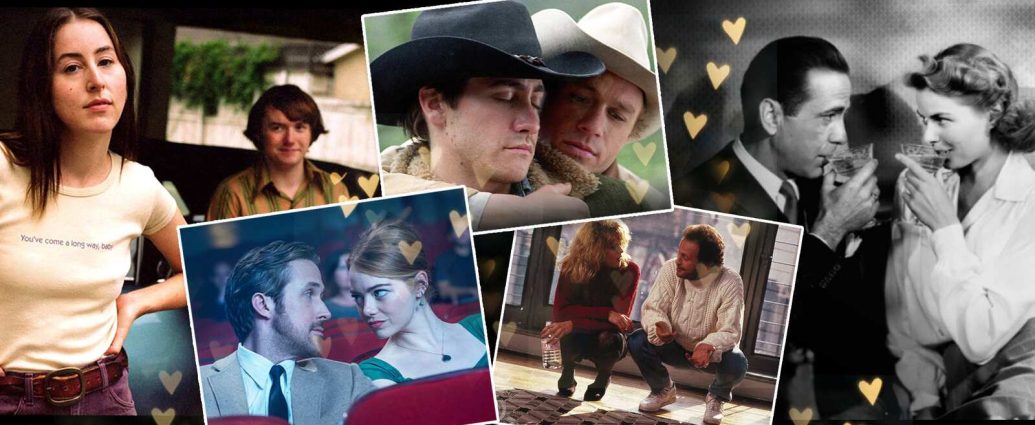This year, the film 7th Heaven entered the public domain. Released in 1927, it won actress Janet Gaynor an Oscar at the first Academy Awards, the first of the three she won for best actress. The three films were all romances – Gaynor played a waif forced into prostitution in two of them, and as a housewife with a husband who plans to leave her, in the third. Like all silent movies, they are heavy on melodrama, and on the redemptive power of love. They also offer a fascinating starting point to any study of the romance movie.
Of course, great love stories have existed as long as humans have told stories. Almost every culture has its version of the tale of the star-crossed lovers – a term popularised by Shakespeare’s Romeo and Juliet. Many have been adapted into film: Heer and Ranjha; Laila and Majnu; Salim and Anarkali; Ambikapathy and Amaravathi; Antony and Cleopatra…
Then there are the stories of couples that have seeped into the popular consciousness purely because of cinema – Jack and Rose; Zhivago and Lara; Rhett and Scarlett; Rick and Ilsa. These are the searing sagas of volcanic passions, set against the backdrop of a world gone mad – where wars, revolutions, evil wizards or passing icebergs prevent the happily-ever-after. Because, after all, unrequited love is purer than the messiness of marriage, and a good cry can be cathartic.
And there are the romcoms – which, cyclically, seem to be everywhere all at once, then suddenly fall out of fashion. The cinema of the 1930s and the 1990s was defined by the popularity of romantic comedies. The 1990s romcom boom can be said to have started in 1989, with Billy Crystal and Meg Ryan in When Harry met Sally…, the movie that established Ryan as the romcom queen of that age. She followed that up with the underrated Joe Versus the Volcano, the first of her three films with Tom Hanks. Then came Sleepless in Seattle, IQ, French Kiss (with Kevin Kline as an improbable Frenchman), Addicted to Love, and the blockbuster hit You’ve Got Mail (1998). Ryan also starred in a more serious romance, City of Angels, now remembered more for the song Iris by Goo Goo Dolls.
It wasn’t just Ryan’s decade. Julia Roberts had her star-making performance in Pretty Woman in 1990, and ended the decade on an equally high note, with Notting Hill, sprinkling films such as My Best Friend’s Wedding and Runaway Bride in between. Sandra Bullock was the Hollywood everygirl in love. While You Were Sleeping (1995) was a monster hit, as was Two Weeks Notice (2002).
On the spear side, Hugh Grant made a career out of playing the absent-minded, upper-class romantic hero. George Clooney starred in One Fine Day and Out of Sight. Even the most unlikely male stars took on romantic leads in the ’90s: Harrison Ford in Sabrina and Six Days, Seven Nights; Jack Nicholson in As Good As It Gets; Mel Gibson in What Women Want; even Al Pacino in Frankie and Johnny.
The 1990s were a great decade for traditional love stories as well. The shadow of Titanic (1997) looms over every other film, but there was Clint Eastwood and Meryl Streep in The Bridges of Madison County; Michelle Pfeiffer and Daniel Day-Lewis in The Age of Innocence (which Martin Scorsese called his most violent film); The Bodyguard, with Kevin Costner and Whitney Houston; the paranormal superhit Ghost, with Patrick Swayze and Demi Moore; the Brad Pitt blockbusters Legends of the Fall and Meet Joe Black. The list goes on…
***
Perhaps the only other decade where the romance genre played such a significant role was the 1930s, which saw the rise and rise of the screwball comedy. Frank Capra’s seminal It Happened One Night (a socialite falls in love with a reporter) and Howard Hawks’s Twentieth Century (an ill-tempered theatre director tries to win back the star he made and then chased away) came out in 1934 and kicked off a trend that would last well into the war years. Both Hawks and Capra would make some of the best-known and most-loved romcoms of Hollywood’s Golden Age, Capra with sentimentality and social consciousness, and Hawks with his whip-crack dialogue and battle-of-the-sexes themes.
The two great decades for love stories couldn’t have been more unlike. The 1930s were hard years. The Great Depression loomed over everything. Jobs were scarce, joy was scarce, bread was scarce. People went to the movies to escape.

If theatre was for the elite, films were being created as a way for the masses to lose themselves in the fantasy lives of the affluent. The genre, at this time, templatised love stories about mismatched couples from different social classes overcoming their differences in entertaining ways, as in Bringing Up Baby and Holiday (an heiress and a scientist; a poor man and a rich woman; both 1938).
The comedy was slapstick but it touched upon the rapid social change in the American moral code of gender and family dynamics. Remarriage was a recurring plot point in screwball comedies, as was the strong and stubborn female protagonist. Films such as The Awful Truth (1937) and The Philadelphia Story (1940) hinged on the banter of couples navigating the tricky terrain of divorce, while others such as My Man Godfrey (1936; an heiress falls in love with a tramp) offered the financially struggling middle classes an opportunity to laugh at the unhinged and frivolous nature of high society
The 1990s, by contrast, were years of great prosperity and great technological progress. The Cold War had ended. And while there were wars in Iraq and Kosovo, there was also a feeling that the world was coming together to make things better. Problems that had plagued the world for decades, if not centuries, were being solved.
The romcoms of the ’90s were a direct reaction to the blockbuster boom of the late-’80s. The ‘70s and ‘80s had seen the rise of filmmakers such as Scorsese, Sidney Lumet and Alan Pakula, whose relentless search for realism chronicled the gritty, turbulent sides of life. Then came the punch-throwing, gun-toting Arnold Schwarzenegger, Sylvester Stallone, Bruce Willis and Jean-Claude Van Damme in a slew of testosterone-driven action hits. Romcoms provided the much-needed respite from the endless slog of reality and guns and car chases.
They were simple, aspirational and almost formulaic: A meet-cute, a misunderstanding, an epiphany and an eventual happily-ever-after. This recipe for success brought in huge profits. You’ve Got Mail was made on a $65 million budget and went on to make over $250 million.
But the cookie-cutter, cliché-ridden approach led to its own decline. Romcom stars yearned for meatier roles. Audiences longed for the element of surprise.
As plots got more threadbare and lacklustre, romcoms were relegated to the backburner. By the 2000s, the genre was being reimagined by a new, more-inclusive generation disillusioned by unrealistic fairytales.

Films such as Eternal Sunshine of the Spotless Mind (2004) examined the messiness that comes with love, and the hard work that goes into it. Jennifer Lawrence’s portrayal of the flawed Tiffany in Silver Linings Playbook (2012) won her an Oscar for Best Actress. Love on the big screen was no longer about fantastic spectacles — there were superhero movies to turn to for that. They emphasised the baggage and indecisions, as in The Big Sick (2017), or directly challenged the notion of “love is enough” with Marriage Story (2019), a heart-wrenching tale about divorce. Slice-of-life movies such as Licorice Pizza (2021; an adrift 25-year-old woman is wooed by a besotted male teen actor, in LA) offer a peek into the complicated emotions of unconventional relationships, where love comes in ways that aren’t expected, or indeed welcome.
The white, wealthy, heterosexual lens has been replaced. In the new HBO series The Last of Us, starring Pedro Pascal and Bella Ramsey, love doesn’t make an appearance until the third episode, and when it does, it isn’t anything like you’d expect.
***
With longevity of a relationship no longer the focal point, films don’t have to rely on arcs. There don’t have to be happily-ever-afters. During the screenwriting of When Harry Met Sally, writer Nora Ephron interviewed people who worked for the production company, asking them about how they met their partners. Snippets of these conversations were rewritten and shot with actors and used as interludes through the film.
Those interludes are now the story (think of The Lunchbox or Brokeback Mountain). Even when the tale isn’t one of everyday people living their lives, the twist is generally a given. La La Land (2016), a musical set in glittering Hollywood, about love and music and movies, opts for a dose of bittersweet realism at the end: two people go their separate ways and can’t say it didn’t pay off.
Today, the romcom as we knew it is inarguably at a low ebb. It’s hard to even tell the titles apart (they usually have a bride or maid or wedding in them). The love stories finding takers, particularly in the new ecosystem of streaming platforms, are those that hadn’t been told before. Think of Up or The Shape of Water. Or just watch the third episode of The Last of Us. Real love is out there. It doesn’t look like what we’d grown accustomed to seeing; it doesn’t fill the screen with candy colours. And thank goodness for that.
Enjoy unlimited digital access with HT Premium
Subscribe Now to continue reading

